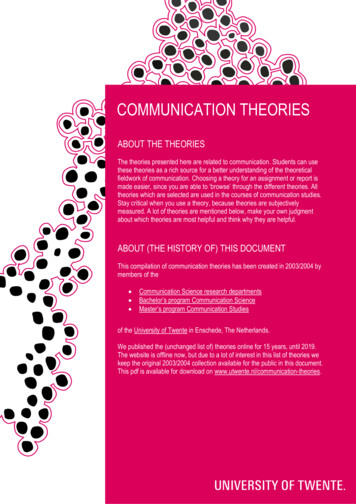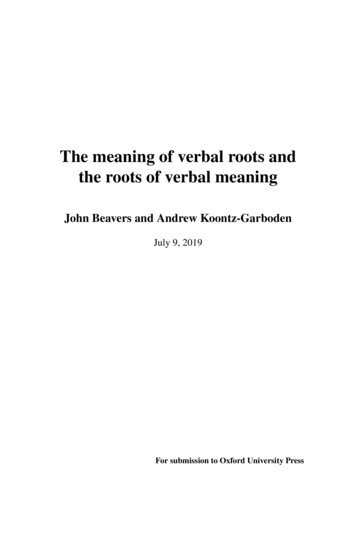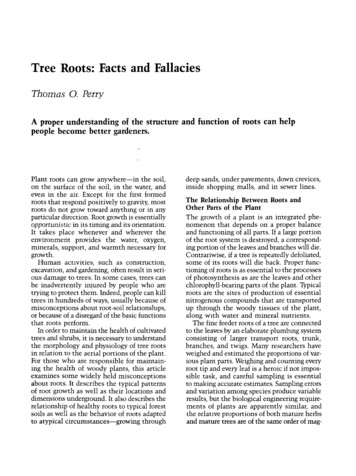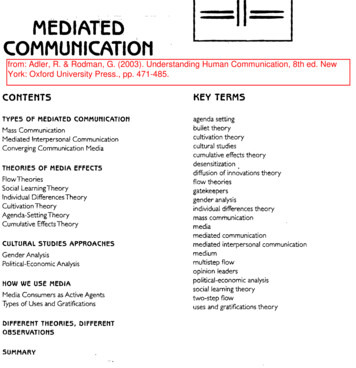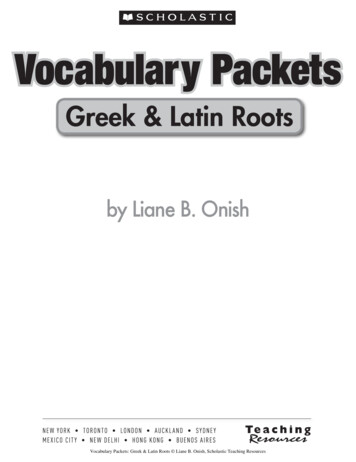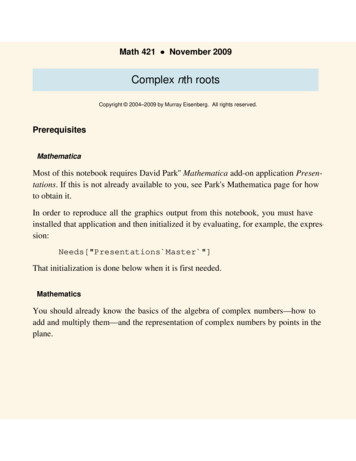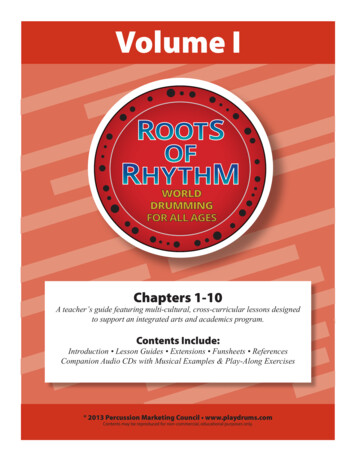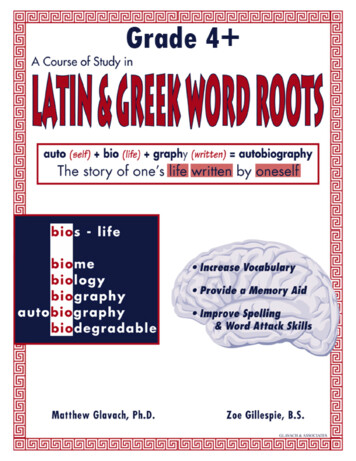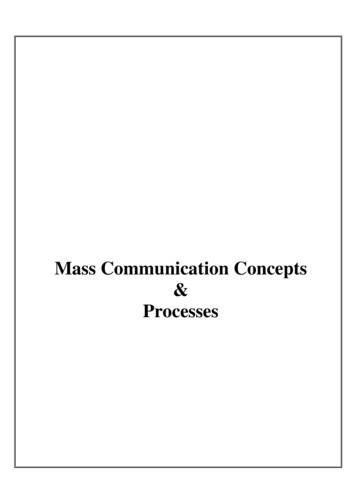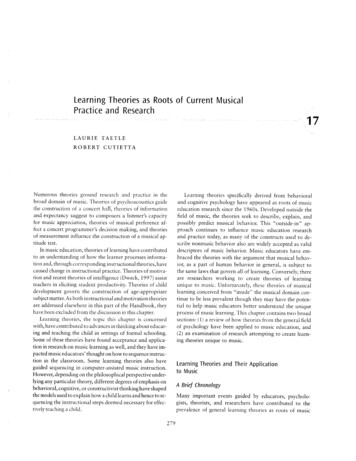
Transcription
Learning Theories as Roots of Current MusicalPractice and Research17L A U R I E TAETLEROBERT CUTIETTANumerous theories ground research and practice in thebroad domain of music. Theories of psychoacoustics guidethe construction of a concert hall, theories of informationand expectancy suggest to composers a listener's capacityfor music appreciation, theories of musical preference affect a concert programmer's decisión making, and theoriesof measurement influence the construction of a musical aptitude test.In music education, theories of learning have contributedto an understanding of how the learner processes information and, through corresponding instructional theories, havecaused change in instructional practice. Theories of motivation and recent theories of intelligence (Dweck, 1997) assistteachers in eliciting student productivity. Theories of childdevelopment govern the construction of age-appropriatesubjectmatter. As both instructional and motivation theoriesare addressed elsewhere in this part of the Handbook, theyhave been excluded from the discussion in this chapter.Learning theories, the topic this chapter is concernedwith, have contributed to advances in thinking about educating and teaching the child in settings of formal schooling.Some of these theories have found acceptance and application in research on music learning as well, and they have impacted music educators' thought on how to sequence instruction in the classroom. Some learning theories also haveguided sequencing in computer-assisted music instruction.However, depending on the philosophical perspective underlying any particular theory, difieren! degrees of emphasis onbehavioral, cognitive, or constructivist thinking have shapedthe models used to explain how a child learns and henee to sequencing the instructional steps deemed necessary for effectively teaching a child.Learning theories specifically derived from behavioraland cognitive psychology have appeared as roots of musiceducation research since the 1960s. Developed outside thefield of music, the theories seek to describe, explain, andpossibly predict musical behavior. This "outside-in" approach continúes to influence music education researchand practice today, as many of the constructs used to describe nonmusic behavior also are widely accepted as validdescriptors of music behavior. Music educators have embraced the theories with the argument that musical behavior, as a part of human behavior in general, is subject tothe same laws that govern all of learning. Conversely, thereare researchers working to créate theories of learningunique to music. Unfortunately, these theories of musicallearning conceived from "inside" the musical domain continué to be less prevalen! though they may have the potential to help music educators better understand the uniqueprocess of music learning. This chapter contains two broadsections: (1) a review of how theories from the general fieldof psychology have been applied to music education, and(2) an examination of research attempting to créate learning theories unique to music.Learning Theories and Their Applicationto MusicA Brief ChronologyMany important events guided by educators, psychologists, theorists, and researchers have contributed to theprevalence of general learning theories as roots of music279
280PART III. MUSICAL DEVtLOFMENT AND LEARNINGeducation research and practice. These contributions,mostly influenced by educational psychologists, began withthe educational and societal transitions of the 1960s. Interest in learning theories gathered momentum during theyears of the Ann Arbor Symposia and continué to be impacted by technological advances, the resurgence of interest in "learning through doing," and—related to it—theapplication of "situated learning" to the study of musiclearning.Prior to the 1960s, little evidence supports learning theories as important foundations of hypothesis-driven research in music education. The decade of the 1960s, however, focused on how learning theories could serve in theimprovement of curriculum development and instruction.For example, Bruner (e.g., 1960,1966) introduced theoriesof conceptual learning that led to a cal! for developmentally sequenced curricula. Bruner, influenced by the translation of Jean Piaget's research into English, theorized hisown developmental stages of learning, which have foundwide acceptance in a number of subject matters, includingmusic. At the same time, behaviorist theories focused onthe application of stimulus-response learning to the improvement of instructional strategies.As Mark (1986) observed, the Tanglewood Symposiumin 1967 and the resulting Music Educators National Conference (MENC) Goals and Objective (GO) Project in1969 prometed the "application of significan! new developments in curriculum (and) teaching-learning patterns"(p. 59). Bruner's spiral curriculum and emphasis on conceptual learning became the foundation of an elementalapproach to teaching music. Aesthetic education (Reimer,1970) gained momentum as music educators sought to secure the valué of the arts in education. Here, too, Bruner'smodel of learning served as the basis for developing teaching strategies that would reach the goals of aesthetic education.In the late 1970s and early 1980s, the Ann Arbor Symposia on the Applications of Psychology to the Teachingand Learning of Music reinforced the relationship betweenlearning theories and music education research and practice. Leading music education researchers met with psychologists to determine how knowledge and expertise fromboth domains could improve scientific inquiry in music education. The original title of the Ann Arbor Symposia," Implications of Learning Theory to the Teaching andLearning of Music," reveáis one of the symposia's purposes: to strengthen the case for research and teachinggrounded in learning theory.In 1978, MENC and the Music Educators ResearchCouncil (MERC) created the Special Research InterestGroups (SRIGs). The titles of two of these original interestgroups—Perception and Cognirion; Learning and Development—indicated the interest in the community of musiceducation researchers to make cognitive learning theoriesintegral components of their work. Since then, the accessibility of the computer has added to the practice of usinglearning theories as a theoretical basis not only for researchon music learning but also for seeking to improve instruction. Programmed instruction based on behavioral learningtheories has evolved into computer-assisted instruction(CAÍ). More recently, computer programmers have createda form of artificial intelligence (AI) that simúlales humancognition or thinking; the impact of AI has broadened research involving the learning theory of human informationprocessing (HIP) as well as the constructionist school ofthought, which uses interactive models to explain learning.In fact, the renewed interest in Bruner's writings (1990,1996) as well as recent translations of Vygotsky's teachingsfrom Russian to English (l Q 97a, 1997b) suggest a strongerfocus on cognition and constructivism as theoretical basesfor explaining the nature of how an individual learns thanseems to have been the case for the 1970s and 1980s.Nonetheless, as has been the case with behaviorist learningmodels, they were always readily and quickly applied toinstructional practice, regardless of how systematicallytheir construct validity had been tested.Majar Theoretical ConstructsIn this chapter, learning theories are restricted to trióseidentified as behavioral, cognitive, and constructivist. Thebehavioral model has as its base the linear connection between stimuli that trigger responses. This model allows theresearcher to look for those external forces that increasethe likelihood of desired behaviors. These models are useful when one studies group or individual behavior in avaríety of instructional settings.Cognitive models describe learning behaviors from amore internal, developmental perspective, in that age, maturation, and perceptual experiences in combination makea learner take in new information in a stepwise process ofexposure, reaction to the exposure, examination of the experience, and adjustment of previous experiences to newones. Such theories stress the description and examinationof appropriate internal stimuli on the readiness for newones. Furthermore, the models seek to explain how an individual negotiates oíd and new information in relationship to each other. Such an approach requires study oflearners as they respond individually to specific tasks.Constructivist models of learning focus on describing indetail the many relationships that connect the learner tohis or her internal as well as external environments. Theenvironments include experiences and contacts with boththe physical and the mental world by the learner both asan individual and as a member in a particular group. Asthe interactive nature of all experiences together results inlearning, constructivist theories tend not to sepárate eitherinternal or external stimuli or what constitutes a stimulus
CHAPTFR 1 . L E A R N ' N G THEORIES AS ROOTS OF CURREN! MUSICAL PRACTICEor a response. Similarly, it is not always clear what sets aconstructivist theory apart from an instructional theory or,because of the cióse connection between any such theoriesand motivation theories, either of the former from the latter.Constructs of Behavioral Learning Theories. Behaviorallearning theories emerged from an effort to move awayfrom the humanistic tradition of analysis through introspection and interpretation. To make research more robustand scientific, directly observable behaviors were to leadto laws of behavior. Eor behaviorists, learning ischange in a subject's behavior or behavior potential to agiven situation brought about by the subject's repeated experiences in that situation, provided that behavior changecannot be explained on the basis of the subject's nativeresponse tendencies, maturation or temporary states.(Bower & Hilgard, 1981, p. 11)Alfhough goals of behaviorism realize a cióse relationship between environment and organism and emphasizeactive learning (Wilson & Myers, 2000), action is ultimateiy determined by environment rather than by self.There are several theoretical subsets of behaviorism. Oftrióse, operant conditioning influenced music education researchers who sought to develop instructional theories derived from behaviorist models.The theory of classical conditioning introduced by Pavlov (1927) claims that a natural emotional response is associated with a neutral stimulus to the extent that the neutral stimulus alone will elicít the response. Building onPavlov's theory, Thorndike (1932) maintained that astimulus-response (S-R) connection constituted the basiclearning unit. His connectionism included (1) the law ofreadiness, which maintained that one must be physicallyand motivationally ready in order to learn; (2) the law ofeffect, which says that responses followed by satisfactionwill be strengthened; and (3) the law of exercise, whichregards rewarded practice (as opposed to blind repetition)as key to learning. Watson (1925) defined the mind as atabula rasa (a blank slate) and postulated both the law offrequency and recency to describe effective reinforcement.Guthrie (1935), via his contiguity theory, asserted that thelast or most recent association between stimulus and response is the one that is retained (principie of postremity).He claimed that a single connection between stimulus andresponse constituted learning. Hull (1951) introducedcharacteristics of the organism as intervening variables inhis stimulus-organism-response (S-O-R) model. Spence(1956) extended Hull's ideas through concepts such ashabit strength, drive, and incentive motivation.The theory of operant conditioning, developed by Skinner (e.g., 1948, 1953, 1968), says that reinforcements281strengthen responses, and his law of extinction says theopposite: that lack of reinforcement weakens response.While he carne to acknowledge mental events as real andmeasurable, Skinner consistently held that causes of mentalchange (learning) lie ultimately in the environment. Xonetheless, rather than a response elicited by the environment.the individual organism (operant) acts on the environment.emitting a response that alters it in some way. Skinner applied these laws extensively to research on instructionalpractice. He believed that students should enjoy and wantto learn, that reinforcement should be consistent and positive, and that because students learn at different paces,instruction should be individualized (Schunk, 2000). Skinner argued that the proper arrangement of reinforcementcontingencies (presentation of appropriately broken-downand sequenced material, active student response, immediate and appropriate feedback, individual pacing) are central to effective learning. Theorists building on Skinner'sideas have advocated curricula based on behavioral objectives, programmed instruction, contingency contraéis, andpersonalized systems of instruction.Applications to the Study of Music Learning. Much of theresearch of Clifford Madsen, Robert Duke, Harry Price,and Cornelia Yarbrough follows the operant conditioningmodel of learning. Their research has focused on instructional principies that guide "good" or "successful" teaching. Here, the role of appropriate and inappropriate reinforcement is integral to understanding learning behaviors.In this regard, researchers in music education have lookedat a wide variety of issues regarding the effect of reinforcement (praise) and feedback (verbal corrections) on musicaldiscrimination, attitude, and performance. More recent reviews of íiterature are by Duke and Henninger (1998),Taylor (1997), and Madsen and Duke (1985). In addition,the use of music itself serving as a mechanism of reinforcement has been studied, among others, by Greer (1981) andMadsen (1981). (For more information, also see chapters18 and 19.)The behaviorist learning model has significantly impacted music researchers' interest in programmed instruction and CAL Programmed instruction, for the most part,involves programmed sequential patterns. The general ideais that a teaching machine (ranging from sequences ofworksheets to CAÍ) can provide appropriate stimuli in theform of digestible bits of information, elicit responses inthe form of easily accessible questions, and provide feedback/reinforcement through additional information and/orpraise. Initially, programs were linear in that all studentswent through the same process, though at varying speeds;later programs were branched, allowing for more advanced students to skip material. Reviews of programmedinstruction and the use of CAÍ in music education practiceare provided by Orman (1998) and Higgins (1992). A re-
282PART III. MUSICAL DEVELOPMENT AND LEARNINGlated área of research, personalized systems of instruction(PSI, the Keller Plan), has been explored by Jumpeter's(1985) study in which he demonstrated PSI to be an effective mode of instruction in college music appreciationcourses.Constructs of Cognitive Learning Theories. Cognitive theories focus on efforts to map an individual's learning processes as new information is integrated with already familiar knowledge. Often viewed as the antithesis ofbehavioral theories, cognitive learning theories developedas reactions to and/or extensions of behaviorism, althoughtoday the constructs tend to emphasize aspects of selfdetetmination in the learning process. Learners activelyconstruct knowledge on the basis of their reactions to sensory stimuli. Critical to cognitive theories in music education is an understanding of major constructs inherent inGestalt psychology as the latter describes cognitive development. Beyond that, constructs of cognitive theories havefound application in theories on HIP and the phenomenonof "connectionism" as applied to brain research.Gestalt psychology is a theoretical subset of Gestalt theory, an early theory of perception developed by Koffka(1935), Kohler (1929, 1969), and Wertheimer (1959).Their theory maintains that learning is insightful and relieson an active process of problem-solving strategies ratherthan on reactions (responses) to random trial-and-error experiences. Gestalt laws state that a person will impose order on perceived disorder according to the laws of similarity, proximity, closure, continuation, and common fate.As the terms suggest, similarity refers to an individualmatching observed objects with others of similar form orcolor; proximity makes an individual relate a perceptionto another one that comes closest to it. Closure indicatesan individual's tendency to want to complete imperfectwholes; similarly, good continuation means that naturalsuccessors will complete an incomplete series of observations or sensations. Finally, "common fate" is the termused to describe an individual attributing characteristics ofthe whole or of parts of the whole to individual parts,based again on "best match." This means that the individual seeks to place component parts of a new experienceinto the already familiar context of previous, familiar experiences.Studies in cognitive development gained in popularityamong educators as a result of Piaget's (e.g., 1928, 1952,1972) observation of young children's learning processes.His resultant theory was both cognitive and developmentalin that it sought to explain (1) how children process information and (2) how those processes change with age.His proposed stages are well known. They have been described as sensorimotor learning, or learning through motor activity and manipulation of objects (age O to 2), topreoperational learning, which is the transformation ofsensorimotor to symbolic learning (ages 2 to 7), to concreteoperations, manifested by increasing ability to classify objects and events (ages 7-11), to formal operations, manifested by thought processes fypical of an adult (age 11onward). Influenced by Piaget, Bruner (1960; Bruner,Goodnow, & Austin, 1956) studied how people activelyselect, retain, and transform information inductively relative to three developmental modes of assimilating knowledge: enactive (experiential), iconic (visual or mental pictures), and symbolic (symbolic systems such as language,mathematics, or musical notation). Bruner's (1966) spiralcurriculum, another construct influential for music education research, proposed to structure learning, and thusteaching, in such a way that any subject, no matter howcomplex, may be introduced at appropriate levéis and periodically with greater levéis of complexity. Piaget also influenced Gardner, who in 1973 began his quest for understanding the arts from a developmental perspective andinfluenced the research conducted for the past several decades by Project Zero.A number of cognitive theorists developed their ideas inresponse to behavioral learning theories. Chomsky (1957)responded to Skinner's ideas about verbal behavior by arguing that language learning is too complex to be explained by behavioral theories. He described language development as a cognitive process involving structuralism:surface structures (individual words as they are spoken orread) and deep structures (grouping of individual wordsinto phrases). Transition from surface structures to deepstructures and vice versa are made possible through whatChomsky called transformational rules. Tolman (1932), abehaviorist with cognitive ideas, postulated that learningcan occur without reinforcement or changes in behavior,that there may be intervening variables and individual differences, that behavior is purposeful and goal-oriented,and that learning results in an organized body of information. Ausubel (1968) disagreed with Skinner's claim thatan individual must emit an active response in order tolearn; he claimed that a student might be cognitively activewithout overt physical action and that expository instruction has its place as long as information is meaningful andcan be applied to previous learning. Associated with theidea that learning involves a hierarchy of instructionalsteps, Gagné (1977, 1985) believed that simpler (behavioral) principies are taught first and then lead to the development of higher order (cognitive) principies.Information-processing theories utilize metaphors fromcomputer science to explain how the mind works. A precursor to information processing was information theory,developed by Shannon (Shannon & Weaver, 1949); heshowed that information could be measured as binarydigits representing yes/no alternatives, which became thefundamental basis of today's telecommunications. Miller,Gallanter, and Pribram (1960) developed an early
CHAPTER. 17. LEARNING THEORIES AS ROOTS OF CÜRRENT MUSICAL PRACTICEinformation-processing model of learning: TOTE (testoperate-test-exit), a feedback circuit whereby behavior isorganized according to assessment; TOTE determineswhether the state of affairs is personally followed, if necessary, by actions to reach an optimal state. Well knownfor his idea of chunking, Miller (1956) believed that shortterm memory (attention span) can only hold seven (plus orminus two) chunks of information. Atkinson and Shiffrin(1968, 1971) originally developed the dual-storage modelof memory: Input enters the brain via the sensory registerand is processed by the working (or short-term) memory;long-term memory influences the working memory andstores perceptions that have relevance and impact (Schunk,2000).A subset of information-processing theories includesconnectiontsm and related theoretical constructs that allowthe study of artificial neural nets as potential models ofbrain function. As a theory, connectionism offers an altérnate paradigm to information processing in that it freescognitive models from dependence on symbolic/metaphoric language. As documented by Beach, Hebb, Morgan,and Nissen (1960), Lashley (1929) demonstrated that neural connections are distributed and that cortical áreas cansubstitute for each other. Hebb (1949), a student of Lashley, postulated that learning is based on modification ofsynaptic connections between neurons. Extending theseideas, Rumelhart, McClelland, and the Parallel DistributedProcessing Research Group (1986) introduced their theoryof parallel distributed processing. In another study of neural mechanisms, Posner and Keele (1968) wrote abouthowneural mechanisms underlie selective attention. The theoryof Schmidt (1975) posited schemas as abstract sets of rulesfor determining movement, as, for example, in motorlearning. Witkin, Moore, Goodenough, and Cox (1977)studied field dependence-independence that "refers to theextent that one depends on or is distracted by the contextor perceptual field in which a stimulus or event occurs"(Schunk, 2000, p. 422).Applications to the Study of Music Learning. The application of cognitive theories to the study of musical learninghas been most prevalent in the use of Gestalt psychologyto explain processing of musical information. Thus, thelaws of similarity, proximity, and closure have been usedto describe and distinguish between processes of music perception, development, and cognition. Wang and Sogin(1990) reviewed the study of Gestalt organizational principies in music. Gestalt concepts also are implicit inKarma's (1985) exposition of hierarchical music concepts.Lehrdahl and Jackendoff (1983) formulated a generative theory of musical grammar based on the linguistic theories of Chomsky. According to Lehrdahl and Jackendorff,acoustic information triggers mental operations that impose order onto input. If there is sufficient exposure to283music, musical understanding will occur through enculturation rather than formal training.Research employing cognitive theories to describe themusical development of children has received the widestattention and emphasis since the 1960s. Detailed reviewsof those efforts have been offered, among others, by Funkand Whiteside (1981), Hargreaves (1986), Hargreaves andZimmerman (1992), Scott-Kassner (1992), and Zimmerman (1986). According to Hargreaves and Zimmerman,Piaget's theory has impacted at least three áreas of researchin music learning: developmental stages; development ofsymbolic function made manifest through language, drawings, and make-believe; and the concept of conservation"according to which young children gradually acquire theunderstanding that two properties of a concrete object cancovary to produce an invariant third property" (p. 378).Zimmerman (née Pflederer, 1964, 1966, 1967; Pflederer 8cSechrest, 1968) is generally acknowledged as a pioneer instudying conservation in music. Swanwick and Tillman's(1986) spiral model of creative musical development alsodraws on Piaget and Bruner. Their model builds on fourdevelopmental stages: (1) mastery (age 0-4) during whichchildren develop a sense of and respond to sounds; (2) imitation (4-9) during which children include the use ofsounds to represent event or objects; (3) imaginative play(10-15) during which children combine sounds creatively;and (4) metacognition (15 and up), during which adolescents reflect on their own thinking about and experiencewith music.Bruner's three modes, enactive, iconic, and symbolicrepresentation, were also the foundation for all of the research and publications of Eunice Boardman Meske.Gromko (1996) investigated children's invented descriptions of songs relative to Bruner's modes of learning andwrote a detailed review of developmental literature, particularly as it evolved from Gardner's (1983) earlier work,including Davidson and Scripp (1988, 1992) and Upitis(1990, 1992). A similarly neo-Piagetian approach wastaken by Elmer (1997), while the "discovery method" advocated by Bruner was investigated in a musical contextby Hewson (1966).As early as in the 1970s, Andrews and Deihl (1970)reviewed the ideas of Bruner and Hebb in music education.Much of the research in concept learning has centered onstudent vocabularies, a topic summarized by Flowers(2000) and Chen-Hafteck (1999). Cutietta (1985) described and applied the hypothesis-testing model of Brunerand others to the development of musical concepts. Boothand Cutietta (1991) explored the possibility that cognitioncan be divided according to Tulving's (1972) theory intoepisodic and semantic memory (verbal processing versusconcept formation). Carlsen (1987) and Adachi and Carlsen (1995) discussed and outlined research according tothe theory of expectancy, which proposes that previous
284PART III. MUSICAL DEVELOPMENT AND LEARNINGmusical experiences and concepts shape how new información is perceived and processed. Thorisson (1997) compared the utility of prototype versus exemplar theory inthe development of musical style concepts in music appreciation texts.Four theories of motor learning have had varying degrees of application in research on music learning: closedloop theory, open-loop or motor program theory, schematheory (mental knowledge), and the Bernstein approach(Gabrielsson, 1999). Applications of the first three havebeen reviewed by LaBerge (1981) and Sidnell (1981a). Twomajor studies conducted by Ross (1985) and Coffman(1990) have focused on mental practice in music learning.Both give ¡nformative reviews of related literature and discuss the positive effect of combined mental and physicalpractice and the theoretical roots of mental practice in thewritings of Tolman (1932) and Kohler (1929, 1969).DeLorenzo (1989) investigated creative thinking from aproblem-solving/problem-finding perspective and gives anextensiva overview of related cognitive studies in musicalcreativity.Research on hemispheric dominance, cognitive style,and field dependence/independence in music education hasseen a proliferation of studies since the 1970s. Baumgarteand Franklin (1981) reviewed studies related to right orleft-brain dominance in musical information processing;they concluded that a number of factors determine wheremusic is processed in the brain and that musical processingis neither completely right- ñor left-brain situated. Hemispheric dominance was also related to learning style in theresearch of Zalanowski (1990). Scheid and Eccles (1975)provided an extensive historical overview of brain hemisphere research and applications in music cognition studies. Strong (1992) examined hemispheric laterality as it related to disabled students' learning. Perhaps the mostextensive discussion to date regarding cerebral hemisphericdominance and/or roles was made by Marin and Perry(1999). Barry (1992) reviewed studies that looked at fielddependence/independence in music performance and perception. (For a more in-depth discussion of field dependence/independence that includes cognitive style, see Ellisand McCoy, 1990.)Information theory for music was initially explicated byAbraham Moles and served as the foundation for the musical understanding theory of Leonard B. Meyer. The application of information theory to music education research was discussed by Krumhansl (1990) in the contextof developing a hierarchical model of musical cognition.These efforts were reviewed by Coffman (1990) in a studymeasuring musical originality and creativity. Informationprocessing theory also was advocated by Williams (1981,1982) and Williams and Peckham (1975), who developeda music information-processing model based on the workof Atkinson and Shiffrin (1968) in verbal-auditory processing and concept development. Tallaríco (1974) described a three-phase concept of memory and how it mightbe implemented in the study of music cognition. In his discussion, he drew from a wide array of sources in information processing, including the writing of Norman, Rumelhart et al. (1986), and Hebb (1949). Cutietta andBooth (1996) provided an overview of research related tocategorization of musical information in memory. In thisregard, Miller's (1956) idea of "chunking" has found frequent acknowledgment in music cogni
tial to help music educators better understand the unique process of music learning. This chapter contains two broad sections: (1) a review of how theories from the general field of psychology have been applied to music education, and (2) an examination of research attempting to créate learn-ing theories unique to music. Learning Theories and .
